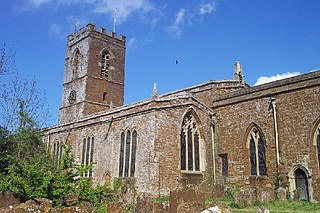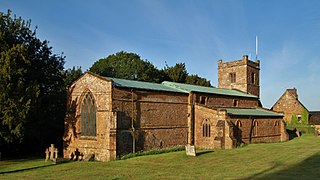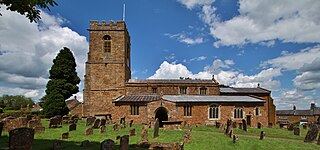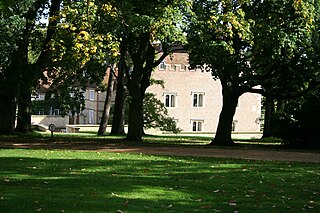
Oxfordshire is a landlocked county in the far west of the government statistical region of South East England. The ceremonial county borders Warwickshire to the north-west, Northamptonshire to the north-east, Buckinghamshire to the east, Berkshire to the south, Wiltshire to the south-west and Gloucestershire to the west.

Stanford in the Vale is a village and civil parish in the Vale of White Horse about 3+1⁄2 miles (5.6 km) southeast of Faringdon and 5 miles (8 km) northwest of Wantage. It is part of the historic county of Berkshire, however since 1974, it has been administered as a part of Oxfordshire. The 2011 Census recorded the parish's population 2,093.

Barnwell Manor is a Grade II listed country estate near the village of Barnwell, about 2.5 miles (4.0 km) south of Oundle, in Northamptonshire, England. The historic former home of the Duke and Duchess of Gloucester, as of 2017 it was occupied by Windsor House Antiques. In September 2022, Prince Richard, Duke of Gloucester, put the manor up for sale for £4.75 million.

Shutford is a village and civil parish about 4.5 miles (7.2 km) west of Banbury in Oxfordshire. The village is about 475 feet (145 m) above sea level. In 1870-72, John Marius Wilson's Imperial Gazetteer of England and Wales described Shutford like this:

Swalcliffe is a village and civil parish about 5 miles (8 km) west of Banbury in Oxfordshire. The parish is about 2+1⁄2 miles (4 km) long north–south and about 1 mile (1.6 km) east–west. The 2011 Census recorded the population of the modern Swalcliffe parish as 210. The toponym "Swalcliffe" comes from the Old English swealwe and clif, meaning a slope or cliff frequented by swallows. The ancient parish of Swalcliffe was larger than the present civil parish, and included the townships of Epwell, Shutford, Sibford Ferris and Sibford Gower.

Adlestrop is a village and civil parish in the Cotswolds, 3 miles (5 km) east of Stow-on-the-Wold, Gloucestershire, England, on the county boundary with Oxfordshire. The River Evenlode forms the southwest boundary of the parish. The village is on a stream that flows southwest to join the river.

Great Milton is a village and civil parish in Oxfordshire, about 7 miles (11 km) east of Oxford. The 2011 Census recorded the parish's population as 1,042.

Shilton is a village and civil parish about 1+1⁄2 miles (2.4 km) northwest of Carterton, Oxfordshire. The 2011 Census recorded the parish's population as 626.

Boltby is a village and civil parish in the Hambleton District of North Yorkshire, England. It is on the edge of the North York Moors National Park at 460 feet (140 m), and about six miles (9.7 km) north-east of Thirsk. According to the 2011 census, it had a population of 143.
John William Beaumont Pease, 1st Baron Wardington, was a British banker.

Mollington is a village and civil parish about 4 miles (6.4 km) north of Banbury in Oxfordshire, England. The 2011 Census recorded the parish's population as 479.

Wardington is a village and civil parish in Oxfordshire, about 4 miles (6.4 km) northeast of Banbury. The village consists of two parts: Wardington and Upper Wardington. The village is on a stream that rises in Upper Wardington and flows north to join the River Cherwell.

Apethorpe Palace in the parish of Apethorpe, Northamptonshire, England, is a Grade I listed country house dating back to the 15th century and was a "favourite royal residence for James I". The main house is built around three courtyards lying on an east–west axis and is approximately 80,000 square feet in area. It is acknowledged as the finest example of a Jacobean stately home and one of Britain's ten best palaces. The building's successive alterations are attributed to three major architects: John Thorpe (1565-1655) for the Jacobean royal extension, Roger Morris (1695-1749) for the Neo-Palladian modifications, and Sir Reginald Blomfield (1856-1942) for the formal gardens and the Neo-Jacobean embellishments. The Lebanese cedar planted in 1614 is a scheduled monument considered to be the oldest surviving one in England.

Ingestre Hall is a Grade II* 17th-century Jacobean mansion situated at Ingestre, near Stafford, Staffordshire, England. Formerly the seat of the Earls Talbot and then the Earls of Shrewsbury, the hall is now owned by Sandwell Metropolitan Borough Council and is in use as a residential arts and conference centre.

Tusmore is a settlement about 5+1⁄2 miles (9 km) north of Bicester in Oxfordshire. It is the location of the Tusmore country house and estate.

Rycote is a hamlet 2.5 miles (4.0 km) southwest of Thame in Oxfordshire. The Oxfordshire Way long-distance path passes through.

Rycote House the manor of Rycote, Oxfordshire, England, was a Tudor country house. First built in the early 16th century, the present site was rebuilt in the 1920s.

Chacombe Priory was a priory of Augustinian canons at Chacombe, Northamptonshire, England.

Ufford Hall is a Grade II* listed manor house in Fressingfield, Suffolk, England, dating back to the thirteenth century.

The Doria Atlas is a 16th-century atlas commissioned by and named for the Genoese military leader Giovanni Andrea Doria. Likely compiled around 1570, it is a composite atlas featuring 186 printed and manuscript maps from two distinct atlases of the Lafreri school. It also contains rare Italian maps dating to the 1620s, in addition to a series of manuscript maps, written by little-known publishers during the 1620s and 1630s and detailing the commercial, political and military interests of the Doria family. As of the 21st century it is one of the world's most expensive books.



















